How Katherine Bennell-Pegg became the first person to train as an astronaut under the Australian flag
Katherine Bennell-Pegg set her sights high. Then put in more work than most of us could imagine. And still her goal appeared to have slipped out of reach...
SA News
Don't miss out on the headlines from SA News. Followed categories will be added to My News.
The dream was over. It was put back in its box, then put on a shelf to be forgotten. It was done. Katherine Bennell-Pegg had given it everything, but it was always a long shot. At the start she was just one of more than 22,000 hopefuls, competing to be chosen as an astronaut by the European Space Agency.
By the end of an 18-month process, and six stages of testing, she made it all the way to the last 25. But finally, painfully, not to the last 17.
“I just figured that was that, put the dream on the shelf, close the box and move on,’’ The Advertiser, Sunday Mail, Sky City Woman of the Year says in the Adelaide HQ of the Australian Space Agency.
There was disappointment. How could there not be? Bennell-Pegg had come so close to achieving a dream nurtured in the backyard of her childhood home at Curl Curl on Sydney’s northern beaches, only to have it taken away when the dream was solidifying into hard reality.
“If you’d known you’ve got that far at the beginning, you’d be so thrilled,’’ she says.
“So, I think it’s because when you get to the end, you can’t protect yourself anymore. You have to go down the rabbit hole of believing it could happen to put in the effort to be competitive.’’
Bennell-Pegg took herself, her husband Campbell and two young children Clara and Hazel to the Flinders Ranges, in the north of South Australia, to recover. In the faraway Flinders, the stars feel close enough to touch.
They were the same bright stars she had seen from her back garden as a girl that had inspired her and made her want to be an astronaut.
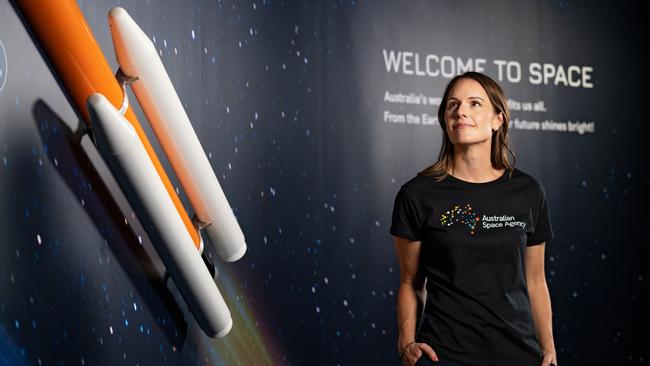
“When I learned that the stars weren’t just pinpricks of light, but whole planets and worlds, or even whole galaxies, the adventure drive in a kid reared up,’’ she says. “I wanted to go there. I wanted to stand on that. I wanted to look at those new horizons with my own eyes and be the one to explore them.”
Up in the Flinders, Bennell-Pegg “put her feet in the dirt’’.
“You kind of get grounded and it’s not about the ego, you just miss the chance to go,” she says.
Anyway, it was not like she had nothing else to do.
Bennell-Pegg is director of space technology at the Australian Space Agency. It’s a job she also loves. After the rejection, her plan was to throw herself back into it, to help Australia build its space agency, its space industry and to encourage young Australians to join in.
Then it all changed again.
Bennell-Pegg could reach up to that box on the shelf, take it down and release the dream. She was going to become the first Australian to train as an astronaut under the Australian flag. It turned out her performance all the way through those six stages of testing had been so good, the European and Australian space agencies created a new category just for her.
After that initial rejection, 38-year-old Bennell-Pegg had been beating herself up a little, asking herself if there was anything she could have done better.
The process even to find herself in that final stage was extraordinary.
The ESA had not called for astronaut nominations since 2009.
So, when it started its process to find a new batch of astronauts in 2021 it was deluged with those 22,000 names.
Bennell-Pegg was not long out of Sydney University when ESA last recruited in 2009. She was too young, too inexperienced to be considered. But she knew when the opportunity came again, she would be putting up her hand.
Unlike many kids who grow up dreaming of space adventure, Bennell-Pegg’s childhood imaginings of navigating among the stars hadn’t faded.
Bennell-Pegg’s mother Maureen was a physicist and her father Peter was a lover of the outdoors and together they encouraged their daughter’s passion for science and adventure.
Bennell-Pegg had a pilot’s licence before she could drive a car. She flew aerobatic planes and later would complete officers’ school for the Army Reserves and volunteered at the State Emergency Service.
At school when she was asked to nominate three possible careers Bennell-Pegg listed only one – astronaut. When it was time to apply for university, she picked aeronautical and space engineering. She says she knew nothing about engineering, had never used a drill and couldn’t tell the difference between a screw and a nut, but applied for the course because it had the word “space” in the title. She also studied for an advanced science degree at the same time, majoring in physics.

The first few years of engineering were a “real slog”, all hard maths and analysis, but she wanted to push through as a matter of pride. As a woman, she was also in the minority and found it “really intimidating” to be surrounded by young men who had grown up building stuff or writing code.
One of Bennell-Pegg’s ambitions is to be a role model for young women who are still vastly outnumbered in engineering studies.
Eventually, when the engineering degree turned to developing something new or creating solutions, she found it was enjoyable. And the concurrent science degree fitted in well.
“The science was the why and the engineering was the how,” is how she describes it.
Bennell-Pegg finished her studies at Sydney University in 2007.
The big question for an aspiring astronaut was – what’s next?
At the time, Australia had no space agency and only a small space industry. If you wanted to be an astronaut, your options were to move to the United States and find a way into NASA or to Europe and the European Space Agency.
At university, Bennell-Pegg took part in a space camp at the Andoya range in Norway, where she helped build and launch a rocket.
It opened her eyes to the possibility that Europe was a viable destination for a hopeful astronaut. It also helped Bennell-Pegg that she held a British passport, courtesy of her mother.
“I left Australia because I didn’t see that it would be possible for me to do what I wanted to do in this country,’’ she says.
Bennell-Pegg moved to Europe in 2008 to undertake the Erasmus Mundus space master program, which included stints at the University of Wurzburg in Germany, Cranfield University in England and a semester above the Arctic Circle in Sweden where it was dark almost 24 hours a day and the temperature was around minus 35C.
Later, she would study space law and policy at the International Space University in Strasbourg, France, plus take further courses at Oxford University and the Massachusetts Institute of Technology.
Bennell-Pegg worked in the space division of the European aeronautical giant Airbus for more than nine years. She worked in project management and systems engineering looking at all manner of space missions, including the removal of space debris, space station architecture and human spaceflight. Her final position at Airbus was as service operations lead for the Bartolomeo platform attached to the International Space Station.
Through all this, the astronaut dream remained alive. Even if it was not always talked about aloud.
“It is not something you shout from the rooftops,” she says. “It’s something that you kind of dream about quietly and you say, ‘Okay, if an opportunity ever came up, would I be in a good position for that?’ It’s something that was always a little bit at the back of my mind.”
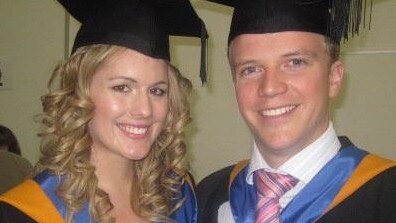
Bennell-Pegg says she always kept an eye on the development of the Australian space industry, but it was not until she visited Adelaide in 2017 for the International Astronautical Congress in Adelaide with her husband Campbell (now head of Spacecraft Development at Fleet Space Technologies) the possibility dawned that it may be possible to continue their careers in Australia.
Bennell-Pegg was on maternity leave back in Germany with her second child when she saw an ad for a job at the fledgling Australian Space Agency. She was scrolling through her phone, baby in one arm, when she saw the agency was hiring technical management. Campbell saw it as well. But there was just the one job being advertised.
They both applied, rationalising that neither probably had enough experience at that stage, but wanting to let the agency know that they were Australians and could be tempted home in the future.
Neither heard anything, but then Bennell-Pegg had a look in her junk folder and saw she had been asked to do an interview. The next day. She phoned her husband, told him to check his spam and the same offer was sitting there for him.
At the time, their house was gutted, ready for renovation and full of workers. They went to a friend’s house to have their interviews.
“They interviewed us separately, while each of us watched the baby,” she remembers.
In a happy ending, and one that helped domestic harmony, both were offered a job.
“We would have been quite happy to stay there (in Germany) a lot longer but we kind of reflected on it and thought, ‘You know if we wait a few years to go back, we won’t have the ability to contribute as much and to use our expertise as much to shape things.’ So it was kind of a now or never.”
Bennell-Pegg had only been to Adelaide for the space conference and once on a school camp. But one thing was obvious to the girl who grew up in Curl Curl.
“If we’re moving back from Europe, we’re going to live on a beach. So we picked West Beach off Google Maps,’’ she says. “It’s got a nice bike path to the city along the river. The crime stats look fine. It’s got a good school. Let’s go.”
Bennell-Pegg started with the ASA in November 2019 as assistant manager in space capability and robotics and automation. In March 2022, Bennell-Pegg was made director of space technology.
By then, she was entrenched in her bid to become an astronaut.
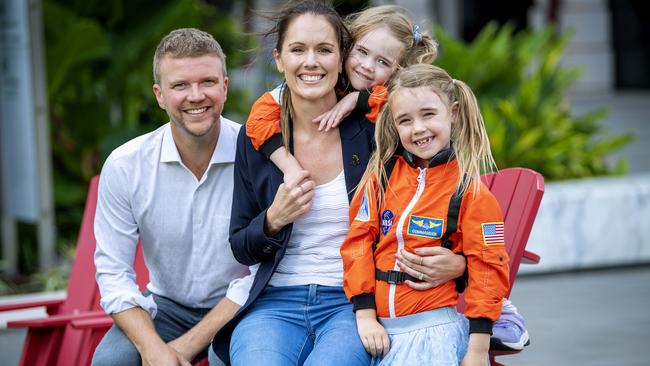
Stage one was simply to apply.But even that was difficult, Bennell-Pegg leaving it to the night before the deadline to send in her application. “To write a motivation letter for something that you’ve wanted for so long, is surprisingly hard to put into words and be meaningful and not clichéd and to express what you want to say,” she says.
At the first stage, the 22,000 dreamers were cut to just 1300.
She survived the first cull and was flown to Hamburg, Germany, for the next round. This was September 2021, Covid was still in full swing, borders were closed and international travel difficult. Her travel agent’s advice?
“Don’t get Covid, because otherwise it might be a few months before you can get back,” Bennell-Pegg recalls. “I was worried that I might get stuck over there and when you’ve got two little kids, that’s not ideal.”
In Hamburg, it was mainly computer-based testing. There were maths tests, physics tests, English tests. Tests for memory, concentration, co-ordination. Essays on personal strengths and weaknesses. At no stage were they told what constituted a pass for any particular assessment.
A lot of it was designed to see how someone would cope under pressure. It was exhausting. And they had to bring their own stimulants.
“There’s no coffee machine at the centre, so we’re all carrying little paper cups from the hotel with five cups of coffee to get through the day and packs of jelly beans,” she says.
Again, Bennell-Pegg made the cut. There were now between 300 and 400 of the original 22,000 still in the running. The next visit to Hamburg was for the psychological tests. Did a candidate have the right stuff to be an astronaut? Can you live and work with a small number of people for a long time in a confined environment? Would you be a good role model to inspire young people to become interested in space?
Again, it was difficult. “You don’t know exactly what they’re looking for. You can’t game the system, they’re going to see into your soul and any kind of pretence, I think, would be frowned upon.”
Not that Bennell-Pegg left it all to chance. She talked to friends in human resources for tips on how to handle group interviews.
Again, she survived. The next round was medical. “I never thought I’d get to the medical but I always assumed if I did that would be kind of the end of the road for me,” she says.
“You know, I’ve had two kids, I’ve had low iron before. I was on thyroid medication for my second pregnancy. You just assume all these things will rule you out.
“And it’s every medical test you could imagine without cutting you open basically. I’ve never had to have those kinds of invasive tests for a job before.”
Again, Bennell-Pegg did all she could to prepare. She took up running to become as fit as she could be and would ride her bike to work.
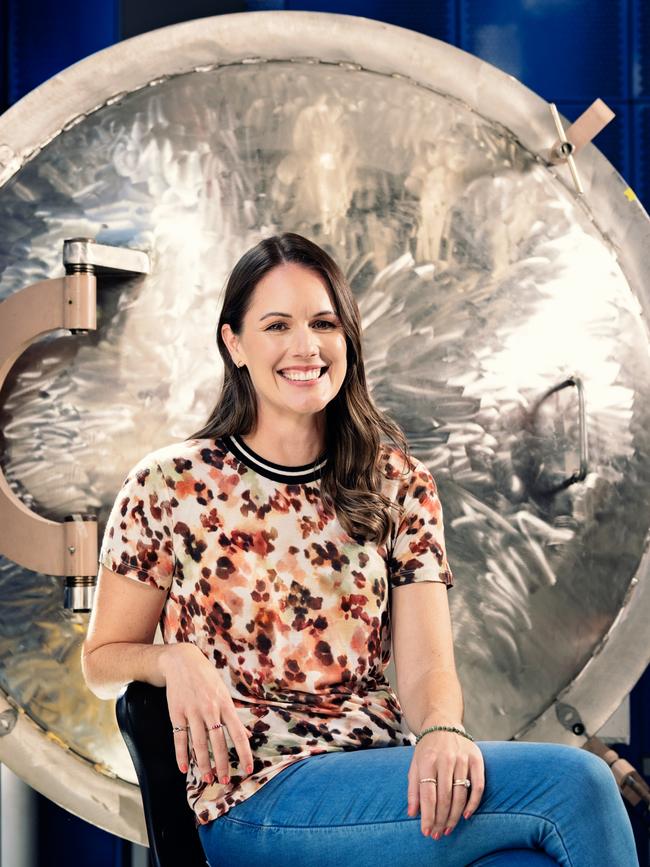
The medical round was in Toulouse in the south of France. Home to great food and wine. Not that Bennell-Pegg and her fellow applicants were indulging themselves.
“The chefs would come out, proud of their menu, and we’d all take a salad and water,” she says. All while wearing heart monitors, with bags at their feet containing little dark bottles holding the urine they collected that day.
That stage completed, Bennell-Pegg found herself being invited to stage five. The panel interview. By now there were around 40-50 people left standing.
“That’s when I was like, ‘Oh, wow, game on.’ I could have a real chance here’,” she says
During the earlier psychology stage, one of the questions Bennell-Pegg was asked was how, if she made it through to the latter stages, could she improve her chances.
She thought one of her weaknesses was her day job. It wasn’t operational. She wasn’t a pilot or a surgeon. Bennell-Pegg took a month off from her job to work on that perceived weakness.
In that month (and take a deep breath here), Bennell-Pegg upgraded her scuba licence to become a rescue diver, became a qualified drone pilot and volunteered for Surf Lifesaving SA, took flying lessons, took skydiving lessons and completed an American Institute of Aeronautics robotics course in human spaceflight operations.
At the panel interview there were astronauts and spaceflight experts asking the questions. She was tested on operational competencies. How she would handle certain situations. She had to make impromptu speeches justifying spaceflight. Sometimes questions were asked in different languages. Watches were removed so candidates wouldn’t know the time.
Bennell-Pegg made it through again. This time to the last 25. An interview with the head of the European Space Agency. But in among all the excitement, one doubt was nagging at the back of her mind. One of the criteria for acceptance in the program was that you would be a good spokesperson for space in an astronaut’s home nation. That you would inspire younger generations. Bennell-Pegg had applied on the strength of her British passport.
But, really, she was an Australian.
And in the end that’s what caught up with her, or as it was put to Bennell-Pegg in a debrief session after the announcement, her “limited connections to Europe”.
Which, she says, meant a “weight was lifted” as she had been berating herself for perhaps doing something wrong in that last interview.
“I knew I’d done everything within my control to the best I could. And that’s where it is and I started to move on,” she says.
It was box-and-shelf time. Except it wasn’t. You can’t keep a good dream down.
Bennell-Pegg’s performance through this long process had been so outstanding that the Australian Space Agency and the ESA came to an agreement that she should be trained as an astronaut.
The difference is that Bennell-Pegg will now become the first person to train as an astronaut while wearing the Australian flag.
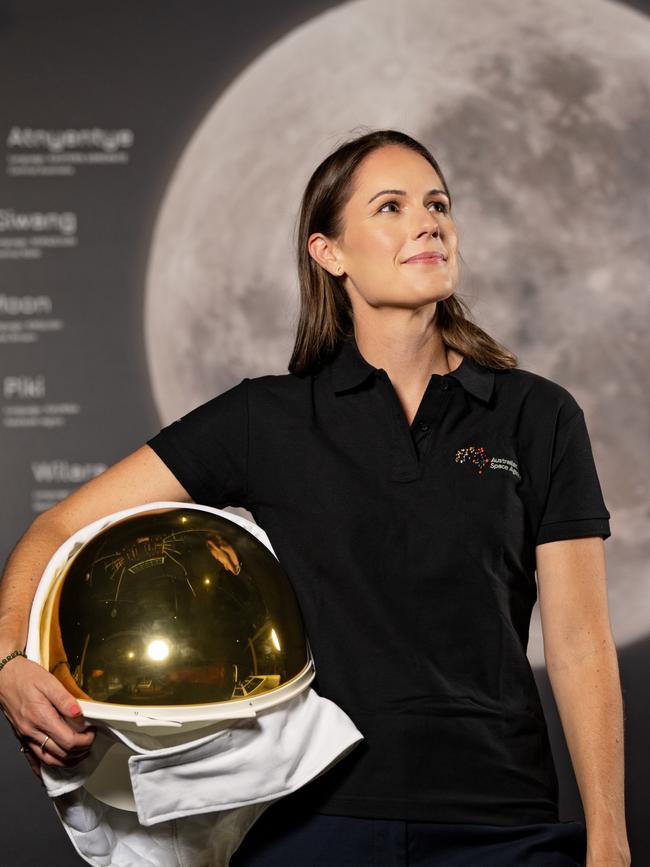
Bennell-Pegg’s boss at the Australian Space Agency is Enrico Palermo.Palermo says it “really reflects the calibre of Katherine and how well she did in the ESA astronaut selection process”.
“Katherine has incredible character, she’s very intelligent, very talented, professional. She’s a good team leader … you look at crews in space, being part of that team environment is critical to safety and human spaceflight, she’s very collaborative,” he says.
Palermo believes Bennell-Pegg’s elevation will benefit the entire local space industry and encourage younger Australians into the science and engineering fields that will be crucial in the long-term development of the industry.
“It really is aimed at how to use space as a gateway to STEM (science, technology, engineering and maths subjects). Through Katherine’s experiences, how do we excite more young Australians to think about a STEM career because all sectors of the economy, not just space, rely on, you know, a much bigger STEM workforce,” he says.
Being that inspiration is important to Bennell-Pegg, especially for young women. When the announcement was made in March that she was chosen for astronaut training, Bennell-Pegg did some media outside the ASA and was approached by some students.
“There were some young women that were quite emotional explaining how hard it is to be a minority in studying their STEM fields, and that it helps them to feel validated that I felt like that too at times,” she says.
Bennell-Pegg, who this year took out the SA Woman of the Year Award, looks to her own daughters – six-year-old Clara and four-year-old Hazel took it all in their stride and didn’t “see it as something overly special, which is great”.
Although, Clara did have one concern.
“Clara thought about it for a bit and she’s like, ‘But you don’t have an astronaut helmet.’ Then she says, ‘Oh, actually, don’t worry. You can borrow mine’.’’
Bennell-Pegg is already in Germany. The official training started last Monday and her family will join her shortly.
The training will take 14 months, while she is technically on secondment from the ASA. She will learn about space systems engineering, spacewalks, basic medical procedures, robotic operations and ocean-survival training.
After all that, there is still no guarantee that Bennell-Pegg will make it into space, but she is closer and reflects it is “mind-blowing” how far she has travelled in the past 20 years.
“I’ve spent my career developing space missions and satellites, and now I get to learn how to fly them. That’s so cool,” she says. “It’s a rollercoaster, an absolute rollercoaster. I hung the dream up on the shelf, and then the dream comes true very shortly after.” ■
Originally published as How Katherine Bennell-Pegg became the first person to train as an astronaut under the Australian flag


